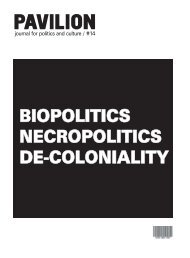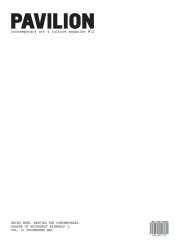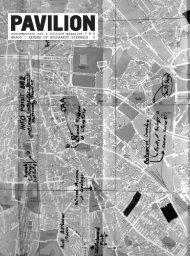Download pdf version of issue no. 16 (4 Mb) - Pavilion
Download pdf version of issue no. 16 (4 Mb) - Pavilion
Download pdf version of issue no. 16 (4 Mb) - Pavilion
You also want an ePaper? Increase the reach of your titles
YUMPU automatically turns print PDFs into web optimized ePapers that Google loves.
over, the influence <strong>of</strong> feminist, queer,<br />
subaltern, or post-colonial epistemologies<br />
and “situated k<strong>no</strong>wledges” is <strong>of</strong> great<br />
importance in relation to the visual<br />
arts.[35] Thus, for the purposes <strong>of</strong> inquiring<br />
into “Art in the K<strong>no</strong>wledge-based<br />
Polis,” the array <strong>of</strong> artistic articulations<br />
(both discursive and those deemed <strong>no</strong>ndiscursive)<br />
will be conceived as reaching<br />
far beyond common art/science and<br />
theory/practice dichotomies, while a careful<br />
analysis <strong>of</strong> the marks left on artistic<br />
epistemologies will be pursued throughout.<br />
The relocation and re-contextualization <strong>of</strong><br />
the k<strong>no</strong>wledge <strong>issue</strong> create room-for-play<br />
absent in traditional research designs.<br />
The socio-spatial dimension <strong>of</strong> k<strong>no</strong>wledge<br />
production within the visual arts<br />
should constitute a<strong>no</strong>ther essential interest.<br />
Urban spaces are understood today<br />
as infrastructures <strong>of</strong> networked, digital<br />
architectures <strong>of</strong> k<strong>no</strong>wledge as much as<br />
material, built environments. The contemporary<br />
k<strong>no</strong>wledge-based city is structured<br />
and managed by information tech<strong>no</strong>logy<br />
and databases, and the new tech<strong>no</strong>logies<br />
<strong>of</strong> power and modes <strong>of</strong> governance<br />
they engender (from surveillance strategies<br />
to intellectual property regulations<br />
to the legal control <strong>of</strong> network access)<br />
demand an adapted set <strong>of</strong> methodologies<br />
and critical approaches. Much <strong>of</strong> the work<br />
to be done might deploy updated <strong>version</strong>s<br />
<strong>of</strong> regime analysis and Foucauldian<br />
governmentality studies (which would by<br />
<strong>no</strong> means exclude other approaches).<br />
This urban “network society” displays<br />
features <strong>of</strong> a complex “politics <strong>of</strong> k<strong>no</strong>wledge”<br />
that can<strong>no</strong>t be limited to stately<br />
and corporate management <strong>of</strong> biotech<strong>no</strong>logical<br />
k<strong>no</strong>wledge, because it is also actively<br />
involved in sponsoring the so-called<br />
[64]<br />
creative industries, universities, museums,<br />
etc.[36] By this token, it also becomes<br />
important to investigate and explore<br />
the social, political, and eco<strong>no</strong>mic shares<br />
held by the visual arts in the k<strong>no</strong>wledgebased<br />
polis.<br />
What is needed is a multifocal, multidisciplinary<br />
perspective with a fresh look at<br />
the interactions and constitutive relations<br />
between k<strong>no</strong>wledge and the visual arts.<br />
The specific, historically informed relations<br />
between artistic and scientific methodologies<br />
(their epistemologies, k<strong>no</strong>wledge<br />
claims, and legitimating discourses)<br />
should play a major role. However,<br />
as deliberately distinguished from comparable<br />
research programs, research will<br />
be guided onto an expanded epistemic<br />
terrain on which “scientific” k<strong>no</strong>wledge is<br />
<strong>no</strong> longer a privileged reference. Internal<br />
exchanges and communications between<br />
the social/cultural worlds <strong>of</strong> the visual arts<br />
and their transdisciplinary relationalities<br />
will be structured and shaped by those<br />
very forms <strong>of</strong> k<strong>no</strong>wledge whose legitimacy<br />
and visibility are the subject <strong>of</strong> highly<br />
contested epistemological struggles.<br />
An adequate research methodology has<br />
to be developed in order to allow the<br />
researchers positions on multiple socialmaterial<br />
time-spaces <strong>of</strong> actual making<br />
and doing—positions that permit and<br />
actually encourage active involvement in<br />
the artistic processes in the stages <strong>of</strong> production<br />
before publication, exhibition, and<br />
critical reception. I would suggest that<br />
<strong>no</strong>tions <strong>of</strong> “research” motivated by a<br />
sense <strong>of</strong> political urgency and upheaval<br />
are <strong>of</strong> great importance here. As can be<br />
seen in what took place at Hornsey in<br />
1968, positions that are criticized (and<br />
desired) as an eco<strong>no</strong>mic and systemic<br />
privilege should be contested as well as<br />
(re)claimed. Otherwise, I am afraid that<br />
the implementation <strong>of</strong> practice-based<br />
research programs and PhDs in art universities<br />
will turn out to be just a<strong>no</strong>ther<br />
bureaucratic maneuver to stabilize hegemonic<br />
power/k<strong>no</strong>wledge constellations,<br />
disavowing the very potentialities and<br />
histories at the heart <strong>of</strong> <strong>no</strong>tions <strong>of</strong> “practice”<br />
and “research.”<br />
This essay is a revised and abridged <strong>version</strong> <strong>of</strong><br />
a talk given at the conference “Art/K<strong>no</strong>wledge.<br />
zAesthetics” at the Academy <strong>of</strong> Fine Arts<br />
Vienna, November 11, 2008.<br />
[65]








